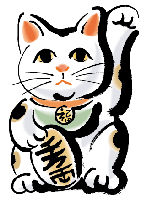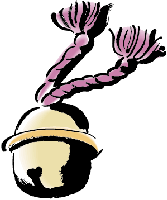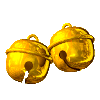
☆ English version Quotation ☆

 ☆ The following has been extracted from " Japanese view".
☆ The following has been extracted from " Japanese view".
*O-mikuji
People pray to a deity, and then choose an oracle which tells their fortune.
there are several means to ask divine will, and some shrines keep a case containing sticks linked to various fortunes. Other shrines write various fortunes on pieces of paper.
※・・・・・The foreign country consult the following.・・・・・
☆You are very lucky !・・・・・『大吉』Daikichi
☆You are fairly lucky !・・・・・『中吉』Chukichi
☆You are just a little bit lucky !・・・・・『小吉』Shokichi
☆You are pretty lucky !・・・・・『吉』Kichi
☆You are lucky alright !・・・・・『末吉』Suekichi
☆You are unlucky !・・・・・『凶』Kyo
☆You are very unlucky !・・・・・『大凶』Daikyo
*The following has been extracted from "Around the Year in Japan".
 Japanese culture has been deeply influenced by the fact that the people had to live in accordance with the changes that occur in each of four different seasons.As a result,there are many things about the customs and ways of thinking in Japan,fostered over hundreds of years in a national environment blessed by a rich variety,that are unique and not seen in other countries.
Japanese culture has been deeply influenced by the fact that the people had to live in accordance with the changes that occur in each of four different seasons.As a result,there are many things about the customs and ways of thinking in Japan,fostered over hundreds of years in a national environment blessed by a rich variety,that are unique and not seen in other countries.
*Engimono - Auspicious Objects
Various kinds of good luck charms are sold at temples and shrines to bring prosperity. Often they must be returned to the shrine at year's end and a new one purchased.
"Maneki-neko" are said to be based on a cat that helped a run-down temple by going into the road in front of the temple and beckoning wealthy patrons.
The round Daruma doll is based on the Zen priest Bodhidharma, who is said to have lost the use of his legs after years of meditation facing a wall. Often only one eye will be painted in, with the other added when one's wishes are granted.
*About green tea
 Tea was introduced to Japan from China during the 9th century,and at first it was used for medicinal purposes,prepared by infusion or else in a powered from mixed with boiled water.
It was only during the 17th century that people began to drink tea made according to the current method,with tea leaves being soaked in boiling water-and even so this was considered an extravagent was of enjoying the beverage and not adopted by the common peple until the 18th century.
Tea was introduced to Japan from China during the 9th century,and at first it was used for medicinal purposes,prepared by infusion or else in a powered from mixed with boiled water.
It was only during the 17th century that people began to drink tea made according to the current method,with tea leaves being soaked in boiling water-and even so this was considered an extravagent was of enjoying the beverage and not adopted by the common peple until the 18th century.
When Japanese drink green tea,they never add sugar or milk: the flavor of the tea itself is what's important-that and the aroma,and the lovely green color.
*About the Japanese love for onsen,or "hot springs"
In some countries,people seen to go to hot springs resorts primarily for the purpose of imbibing the waters,but in Japan a spacious tub or pool.Quite a lot of ingenuity can be seen in the styles of baths and bathing areas,which vary considerably.
But without a doubt,the "king" of the onsen is the roten buro,the open-air bath.
The idea is for bathers to soak in pools built outside,making the most of natural features in the environment.As the bathers soak in the hot water,their faces are caressed by a refreshingly cool breeze.Looking up,they see blue sky.The only sound is the trickle of hot water into the bath,and the breeze wafting through the thickets nearby.It's possible here to feel entirely cut off from the grind of daily life.The bathers forget their daily cares,and refresh their spirits.
*About nabemono,or Japanese "hot pot dishes"
On really cold days in winter, the type of meal is one that warms us up. On bone-chilling cold after-noons in Japan. When people start to think about what to have for their evening meal, somebody is very likely to say, "Let's have nabe for dinner!"
Nabe, or nabemono, is the collective term for xarious kinds of hot pots. They use a wide variety of ingredients, all chosen for a healthy nutritional balance, including seafood of various sorts,meat,vegetables,various mushrooms,tofu or "bean curd" and all kinds of other good things.The specific names for the nabemono are derived from the ingredients and the region of their origin.Nabe include,for example,the Ishikarinabe of Hokkaido,which features salmon,the kakinabe of Hiroshima,which features fresh oysters,and so on.Nabe cuisine thus varies according to the foods available from region to region.
This is how a typical nabe is made.A gas burner,or other type of heating source,is placed on a table,and on top of this goes a large earthen pot,or donabe,filled either with water or light broth (dashi).The ingredients are cooked in the water or broth,so once they've been prepared-washed,cut up,and attractively arranged-that's it.Since everything is eaten right there at the table,cooking doesn't require too much effort for the housewife.
An additional advantage of cooking dinner like this is that it makes little difference how many people are eating,or when they come to the table,as long as there are enough ingredients to go around.
 Title
Title




 ☆ The following has been extracted from " Japanese view".
☆ The following has been extracted from " Japanese view". Japanese culture has been deeply influenced by the fact that the people had to live in accordance with the changes that occur in each of four different seasons.As a result,there are many things about the customs and ways of thinking in Japan,fostered over hundreds of years in a national environment blessed by a rich variety,that are unique and not seen in other countries.
Japanese culture has been deeply influenced by the fact that the people had to live in accordance with the changes that occur in each of four different seasons.As a result,there are many things about the customs and ways of thinking in Japan,fostered over hundreds of years in a national environment blessed by a rich variety,that are unique and not seen in other countries. Tea was introduced to Japan from China during the 9th century,and at first it was used for medicinal purposes,prepared by infusion or else in a powered from mixed with boiled water.
It was only during the 17th century that people began to drink tea made according to the current method,with tea leaves being soaked in boiling water-and even so this was considered an extravagent was of enjoying the beverage and not adopted by the common peple until the 18th century.
Tea was introduced to Japan from China during the 9th century,and at first it was used for medicinal purposes,prepared by infusion or else in a powered from mixed with boiled water.
It was only during the 17th century that people began to drink tea made according to the current method,with tea leaves being soaked in boiling water-and even so this was considered an extravagent was of enjoying the beverage and not adopted by the common peple until the 18th century. Title
Title